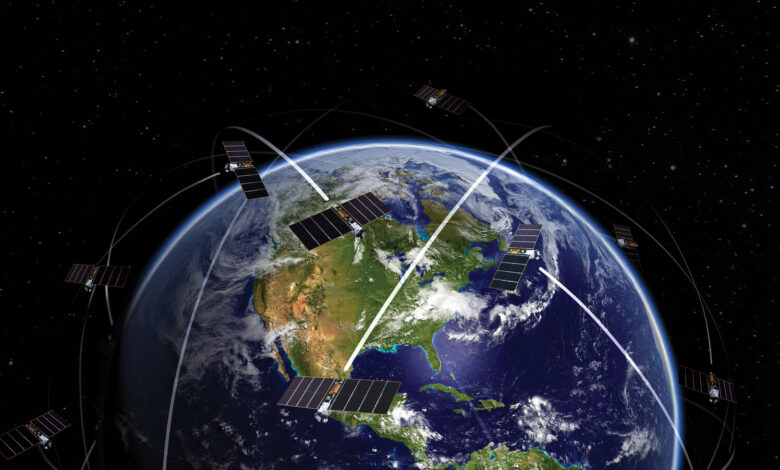
Artificial Intelligence (AI) is evolving from a novelty to a necessity in space systems, serving as an enabler and accelerator for a range of new uses and capabilities for defense, public safety, science and research and commercial applications.
While AI in space has abundant benefits, successfully facilitating AI in space comes with several challenges. The biggest barrier is the inherent nature of space. Space is an extremely harsh environment, with radiation, temperature extremes and limited access to large sources of power, and oftentimes unpredictable and unforgiving conditions pose significant challenges for the function and longevity of technologies.
Before operating an AI-enabled space mission, successful implementation of AI is reliant on the combination of several technologies and digital components, including onboard computing, communication systems, sensors, thermal cooling, finding sources of power, and AI and ML algorithms, among many others. The technologies and electronics used on satellites and payloads must defend against effects of radiation, power all the AI enabled systems, deliver information to the warfighters or individuals here on Earth, and support Low Earth Orbit (LEO), Near-Earth Orbit (NEO), geostationary orbit (GEO) or Deep Space to meet mission needs.
Cognition in the cosmos
As AI migrates from Earth to orbit, a new era in space is emerging, led by innovations enabling use of critical AI technologies in space. Traditionally, satellites have served as passive observers, collecting data and relaying it back to Earth for analysis. But this model is slow, uplink and downlink bandwidth-intensive, and reactive. Time sensitive information is delayed while large amounts of data are delivered to Earth, processed in a ground station and then delivered to the warfighter or individual. Information may not be tactically relevant by the time it’s delivered.
Enter the new AI-enabled satellites that are capable of interpreting data in near real time, directly in orbit. These satellites don’t just see, they understand. At the heart of this shift is AI-at-the-edge: the ability to run trained models onboard, even in the harsh, resource-constrained environment of space. New satellite platforms are pioneering this frontier. Equipped with power efficient AI co-processors and high-order low-resource learning (HO-LRL) algorithms, satellites will soon detect anomalies, recognize patterns and make decisions autonomously, without waiting for ground control and management.
Warfighters or individuals don’t have to wait for the old flow of delivering lots of data from satellite to Earth, process on the ground and then get information; in the future, AI-enabled satellites will deliver information directly to the user without excessively using downlink bandwidth or processing time on Earth.
The new blueprint
This leap has profound implications. The fusion of AI with satellite constellations is redefining what’s possible from orbit. No longer just passive observers, satellites are becoming intelligent agents capable of analyzing, interpreting and acting on data in real time. This shift is unlocking a new era of responsiveness, precision and autonomy in space-based systems that will benefit all of us on Earth. Satellites won’t just be a source of data but will be a source of information and decisions.
1. Turning images from space into insight
Instead of transmitting gigabytes of raw images from space, AI-enabled satellites will identify and understand what they are seeing and provide that insight faster and in a way that is easier to understand directly to the individual.
2. Optimizing communication
AI can improve reliability of communication between satellites or between Earth and satellites by analyzing signals and adjusting signals to keep communication strong and reliable.
3. Helping satellites protect themselves
If space debris is heading towards a satellite, or a solar flare is imminent, onboard AI processing can act on that data and make decisions to protect the satellite without waiting for instructions from Earth.
Decision making in space relies on real-time data and uses it to provide actionable data for the satellite itself or the user. Wildfires can be detected and tracked before they spread. Border incursions can be flagged in real time. Climate shifts can be monitored continuously, not just periodically, researchers can track wildlife migration patterns, or governments can rapidly identify threats that require immediate response. This new class of satellites will be modular, scalable and cost-effective, and will democratize access to orbital intelligence for governments, researchers and industries alike.
The foundation of AI in space: Advanced electronics at work
AI is already proving its value in space missions. One example is the successful atmospheric reentry mission of NASA’s LOFTID (Low-Earth Orbit Flight Test of an Inflatable Decelerator). LOFTID employed AI supercomputers to capture both visible and infrared video images for mission success analysis. The collected camera data offered vital insights into the performance of the next generation heatshield, ultimately facilitating use on future missions.
As we push the boundaries of what’s possible in orbit, cognition in space is no longer a futuristic concept, it’s a present-day imperative. AI is becoming the cornerstone of next-generation space systems, but its success depends on the reliability and intelligence of the hardware that supports it. Space electronics are the foundation of this transformation, enabling AI to operate autonomously, securely, and efficiently in the harshest environments imaginable.
By removing the traditional limitations of connectivity and latency, AI-enabled satellite platforms are proving that real-time decision-making in orbit is not only feasible, but essential. As we look ahead, the convergence of rugged electronics and AI-on-the-edge will define the next era of space exploration and Earth observation, delivering faster insights, reducing mission risk and unlocking new possibilities across industries. The future of space isn’t just about reaching farther. It’s about thinking smarter, from orbit.





